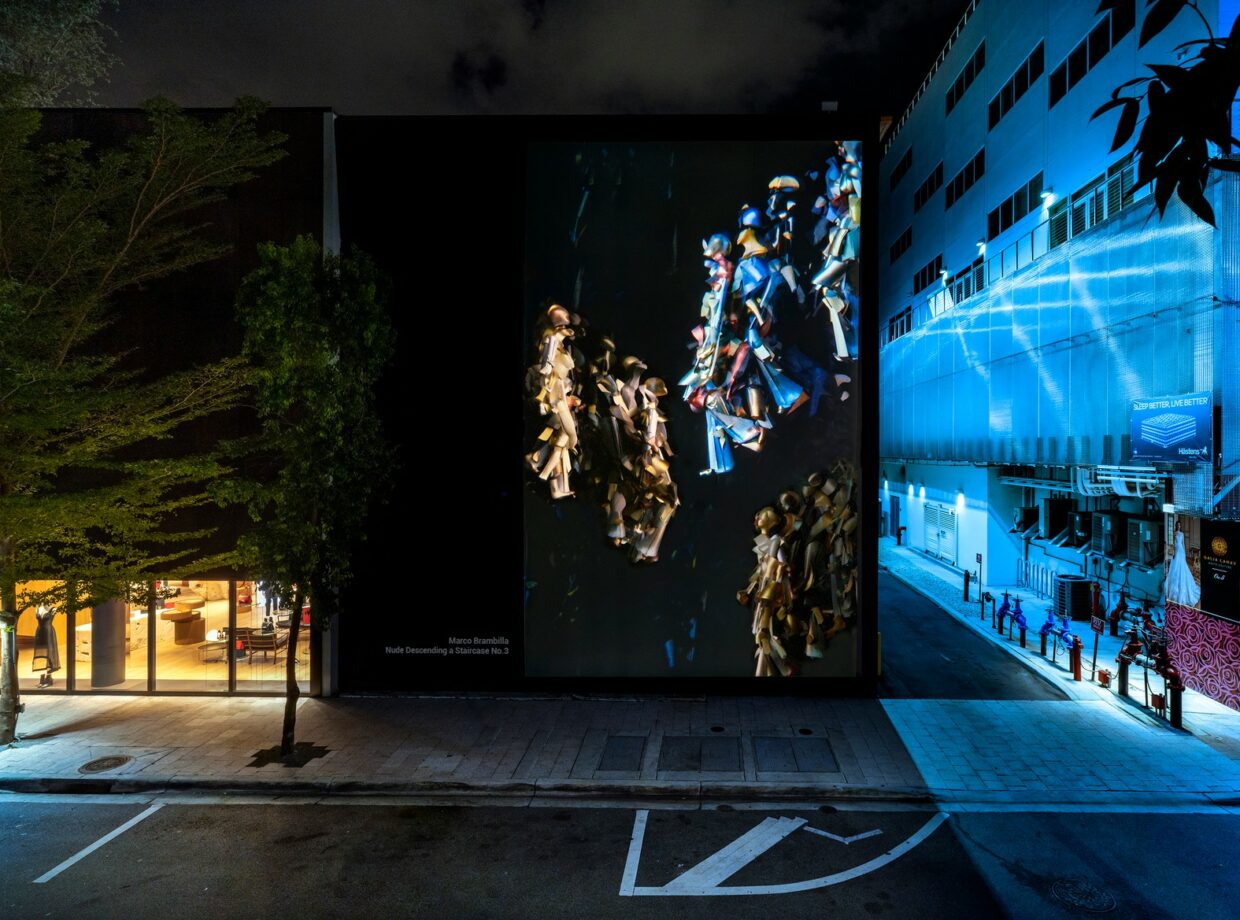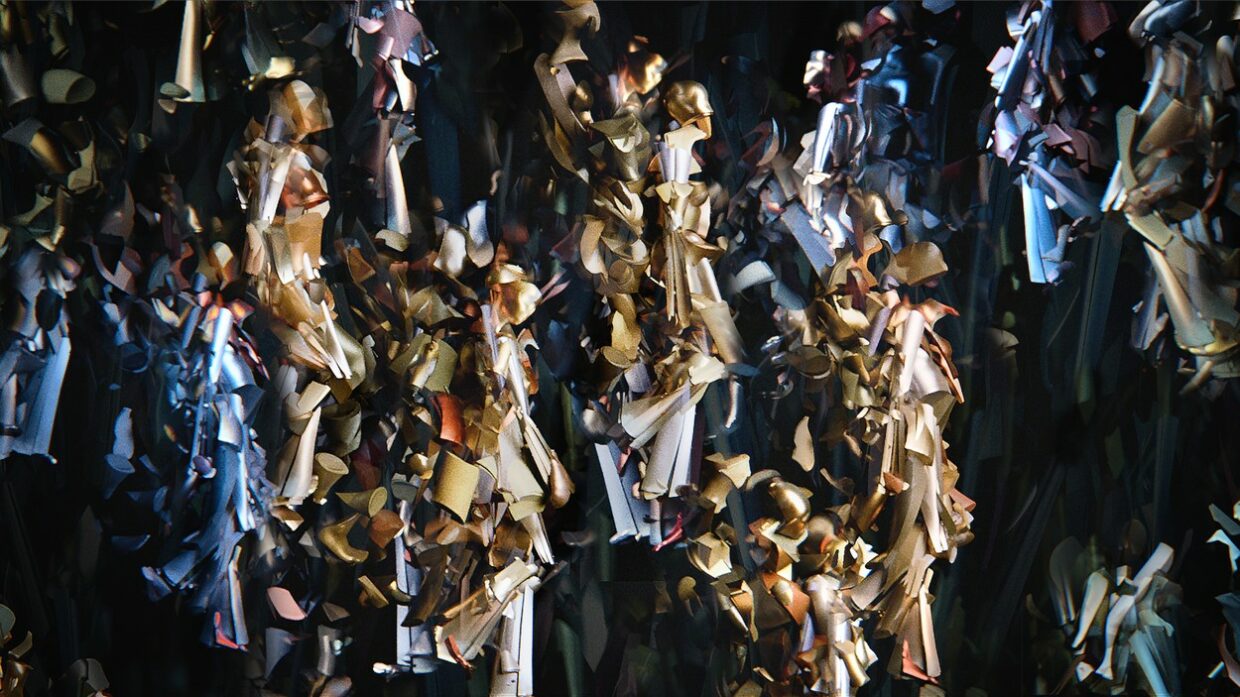Maison Margiela’s Future Miami Boutique Becomes a Blank Canvas
Dec. 4, 2020
Text by Osman Can Yerebakan
A visit to John Galliano’s atelier made the video installation artist Marco Brambilla realize the studio’s resemblance to his own more than a fashion designer’s. After discussing their mutual ideas about digital nomadism over lunch following Maison Margiela’s Fall /Winter 2019 collection, Brambilla, tells GARAGE that he was sure “the collection and the way it incorporated technology into the garments meshed perfectly with where my work with avatars and artificial intelligence was headed.”
Brambilla’s inspiration to create a series of digital “readymades” à la Marcel Duchamp has led to the London-based artist’s aptly titled immersive projection, Nude Descending No. 3, which has reached its full circle in Miami after recently being exhibited in London, New York, and Paris. Between now and Saturday, nighttime passerby in the city’s Design District encounter the projection shrouding Maison Margiela’s upcoming Miami boutique. The fifteen-minute film seamlessly loops for three hours starting at 7 p.m. for visitors gathered for the week-long Design Miami/. The fruit of a desire to digitally reenact Duchamp’s historical 1912 painting Nude Descending No. 2., the hallucinatory film grants the artist with an opportunity to “deconstruct the human form and the body into fragments.”
While the idea of interpreting silhouettes starts on the building’s façade, that very notion will soon permeate the interior as well when the fashion house opens its new flagship boutique in spring 2021. “Much of my work deals with the deconstruction and reconfiguration of moving images,” the artist says about this parallel he sees between his and Maison Margiela’s philosophies. The poetically mysterious Parisian atelier’s traces, however, are already in the building: similar to Duchamp’s inspiration from Eadweard Muybridge’s then-revolutionary time-based photographs of human motion, Brambilla turned to Galliano’s new reflective fabric, China Star, to crystalize his concept. “It would have been a Surrealist’s dream!” The designer’s transformation of the garment into a surface for projection echoes here on a monumental scale, as what the artist considers a “temporary intervention transforming the building exterior into a larger-than-life version of the painting coming to life.”
Brambilla’s technology is rooted in humanity at its core—both pulling cues from Muybridge’s observation of movement and Duchamp’s attempt to subvert it. The process started with the artist motion-capturing people walk down the stairs. At his studio located in London’s Fitzrovia district, he later used the data to create computer-generated collages of figures orchestrating their movements, as if they were floating over imaginary stairs. The cumulative film begins with the first step and piles onto a mass of movements with cyborg-like bodies taking crisp steps that reminisce the sharp simplicity of toy soldiers’ on a black background. “Recreations of the original’s memory,” he explains about the human aspect of his digitally intricate process. He finds this spirit similar to Margiela’s practice of reworking garments to create something new from their memories—“we both re-process and shape images and materials.”
His most recent project included another head-turner name: Cate Blanchett. She appeared in four colors—red, blue, green, and yellow—in his The Four Temperaments video installation, which debuted at Berlin’s Fuchs Galerie in September. Unlike the bodies in Nude, Blanchett was highly there, in close-up, and expressive in her all four selves, yelling first “I love you,” and then the exact opposite. The dismantling in this case was that of human emotions, which the film divided into four categories based on the Greek philosopher Galen: sanguine, choleric, melancholic, and phlegmatic. “The Four Temperaments distinguished between four characteristics through colors,” says Brambillo, who sees that sensibility shared also in this work, “where motion is stylized in the same way as emotion was there, through repetition.”
As an artist working with the subtlety of moving images, Brambillo finds fashion inspiring, not only for the rhythm of a catwalk but also for the designers’ boldness to challenge. “Ironically, fashion has now embraced experimentation and disruption while the art world has generally become more commercial and safe,” he thinks. “The migration of ideas between the two disciplines seems more natural than ever.” Creative anarchy, in fact, starts with his film’s original inspiration: “Duchamp once said he forced himself to contradict his own self in order to avoid conforming to his taste, and that sentiment, I believe, is echoed by Galliano and Margiela himself.”
Source: Garage Weekly

